+ Open data
Open data
- Basic information
Basic information
| Entry | Database: PDB / ID: 7sun | ||||||
|---|---|---|---|---|---|---|---|
| Title | Atomic model of prestin from gerbil (Meriones unguiculatus) | ||||||
 Components Components | Prestin, Enhanced Yellow Fluorescent Protein chimera | ||||||
 Keywords Keywords |  MEMBRANE PROTEIN / MEMBRANE PROTEIN /  MOTOR PROTEIN / Prestin (Slc26a5) / cochlear amplification / NonLinear Capacitance MOTOR PROTEIN / Prestin (Slc26a5) / cochlear amplification / NonLinear Capacitance | ||||||
| Function / homology |  Function and homology information Function and homology informationsecondary active sulfate transmembrane transporter activity / sensory perception of sound / regulation of cell shape / basolateral plasma membrane / membrane => GO:0016020 Similarity search - Function | ||||||
| Biological species |   Meriones unguiculatus (Mongolian gerbil) Meriones unguiculatus (Mongolian gerbil)synthetic construct (others) | ||||||
| Method |  ELECTRON MICROSCOPY / ELECTRON MICROSCOPY /  single particle reconstruction / single particle reconstruction /  cryo EM / Resolution: 3.6 Å cryo EM / Resolution: 3.6 Å | ||||||
 Authors Authors | Butan, C. / Santos-Sacchi, J. | ||||||
| Funding support |  United States, 1items United States, 1items
| ||||||
 Citation Citation |  Journal: Nat Commun / Year: 2022 Journal: Nat Commun / Year: 2022Title: Single particle cryo-EM structure of the outer hair cell motor protein prestin. Authors: Carmen Butan / Qiang Song / Jun-Ping Bai / Winston J T Tan / Dhasakumar Navaratnam / Joseph Santos-Sacchi /  Abstract: The mammalian outer hair cell (OHC) protein prestin (Slc26a5) differs from other Slc26 family members due to its unique piezoelectric-like property that drives OHC electromotility, the putative ...The mammalian outer hair cell (OHC) protein prestin (Slc26a5) differs from other Slc26 family members due to its unique piezoelectric-like property that drives OHC electromotility, the putative mechanism for cochlear amplification. Here, we use cryo-electron microscopy to determine prestin's structure at 3.6 Å resolution. Prestin is structurally similar to the anion transporter Slc26a9. It is captured in an inward-open state which may reflect prestin's contracted state. Two well-separated transmembrane (TM) domains and two cytoplasmic sulfate transporter and anti-sigma factor antagonist (STAS) domains form a swapped dimer. The transmembrane domains consist of 14 transmembrane segments organized in two 7+7 inverted repeats, an architecture first observed in the bacterial symporter UraA. Mutation of prestin's chloride binding site removes salicylate competition with anions while retaining the prestin characteristic displacement currents (Nonlinear Capacitance), undermining the extrinsic voltage sensor hypothesis for prestin function. | ||||||
| History |
|
- Structure visualization
Structure visualization
| Movie |
 Movie viewer Movie viewer |
|---|---|
| Structure viewer | Molecule:  Molmil Molmil Jmol/JSmol Jmol/JSmol |
- Downloads & links
Downloads & links
- Download
Download
| PDBx/mmCIF format |  7sun.cif.gz 7sun.cif.gz | 247.1 KB | Display |  PDBx/mmCIF format PDBx/mmCIF format |
|---|---|---|---|---|
| PDB format |  pdb7sun.ent.gz pdb7sun.ent.gz | 192.2 KB | Display |  PDB format PDB format |
| PDBx/mmJSON format |  7sun.json.gz 7sun.json.gz | Tree view |  PDBx/mmJSON format PDBx/mmJSON format | |
| Others |  Other downloads Other downloads |
-Validation report
| Arichive directory |  https://data.pdbj.org/pub/pdb/validation_reports/su/7sun https://data.pdbj.org/pub/pdb/validation_reports/su/7sun ftp://data.pdbj.org/pub/pdb/validation_reports/su/7sun ftp://data.pdbj.org/pub/pdb/validation_reports/su/7sun | HTTPS FTP |
|---|
-Related structure data
| Related structure data |  25442MC M: map data used to model this data C: citing same article ( |
|---|---|
| Similar structure data |
- Links
Links
- Assembly
Assembly
| Deposited unit | 
|
|---|---|
| 1 |
|
- Components
Components
| #1: Protein |  / Solute carrier family 26 member 5 / Solute carrier family 26 member 5Mass: 111865.805 Da / Num. of mol.: 2 / Fragment: prestin + linker + eYFP Source method: isolated from a genetically manipulated source Source: (gene. exp.)   Meriones unguiculatus (Mongolian gerbil), (gene. exp.) synthetic construct (others) Meriones unguiculatus (Mongolian gerbil), (gene. exp.) synthetic construct (others)Gene: SLC26A5, PRES, eYFP / Cell line (production host): HEK293 / Production host:   Homo sapiens (human) / References: UniProt: Q9JKQ2 Homo sapiens (human) / References: UniProt: Q9JKQ2 |
|---|
-Experimental details
-Experiment
| Experiment | Method:  ELECTRON MICROSCOPY ELECTRON MICROSCOPY |
|---|---|
| EM experiment | Aggregation state: PARTICLE / 3D reconstruction method:  single particle reconstruction single particle reconstruction |
- Sample preparation
Sample preparation
| Component | Name: Prestin dimer surrounded by a belt of detergent / Type: COMPLEX / Entity ID: all / Source: RECOMBINANT |
|---|---|
| Source (natural) | Organism:   Meriones unguiculatus (Mongolian gerbil) Meriones unguiculatus (Mongolian gerbil) |
| Source (recombinant) | Organism:   Homo sapiens (human) / Cell: HEK293 Homo sapiens (human) / Cell: HEK293 |
| Buffer solution | pH: 7.4 / Details: 10 mM HEPES, 200 mM NaCl, 0.02% GDN, pH 7.4 |
| Specimen | Embedding applied: NO / Shadowing applied: NO / Staining applied : NO / Vitrification applied : NO / Vitrification applied : YES : YES |
Vitrification | Cryogen name: ETHANE |
- Electron microscopy imaging
Electron microscopy imaging
| Experimental equipment |  Model: Titan Krios / Image courtesy: FEI Company |
|---|---|
| Microscopy | Model: TFS KRIOS |
| Electron gun | Electron source : :  FIELD EMISSION GUN / Accelerating voltage: 300 kV / Illumination mode: FLOOD BEAM FIELD EMISSION GUN / Accelerating voltage: 300 kV / Illumination mode: FLOOD BEAM |
| Electron lens | Mode: BRIGHT FIELD Bright-field microscopy / Nominal magnification: 81000 X / Nominal defocus max: 2150 nm / Nominal defocus min: 1150 nm Bright-field microscopy / Nominal magnification: 81000 X / Nominal defocus max: 2150 nm / Nominal defocus min: 1150 nm |
| Image recording | Electron dose: 54 e/Å2 / Film or detector model: GATAN K3 (6k x 4k) |
- Processing
Processing
| Software | Name: PHENIX / Version: 1.19.2_4158: / Classification: refinement | ||||||||||||||||||||||||||||
|---|---|---|---|---|---|---|---|---|---|---|---|---|---|---|---|---|---|---|---|---|---|---|---|---|---|---|---|---|---|
| EM software |
| ||||||||||||||||||||||||||||
CTF correction | Type: PHASE FLIPPING AND AMPLITUDE CORRECTION | ||||||||||||||||||||||||||||
| Symmetry | Point symmetry : C2 (2 fold cyclic : C2 (2 fold cyclic ) ) | ||||||||||||||||||||||||||||
3D reconstruction | Resolution: 3.6 Å / Resolution method: FSC 0.143 CUT-OFF / Num. of particles: 111863 / Symmetry type: POINT | ||||||||||||||||||||||||||||
| Atomic model building | PDB-ID: 6RTF Accession code: 6RTF / Source name: PDB / Type: experimental model | ||||||||||||||||||||||||||||
| Refine LS restraints |
|
 Movie
Movie Controller
Controller



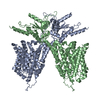

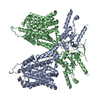
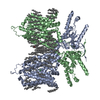
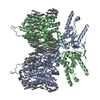
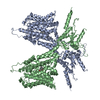
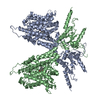
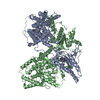


 PDBj
PDBj

